EIF4E1B与HSPA1A和PPP2CA相互作用,参与小鼠卵母细胞成熟和早期胚胎发育
IF 2.4
2区 农林科学
Q3 REPRODUCTIVE BIOLOGY
引用次数: 0
摘要
蛋白质翻译过程是哺乳动物卵生和早期胚胎发育的重要组成部分。真核生物翻译起始因子4E家族(eIF4E)启动真核mRNA翻译过程,在蛋白质合成中发挥重要作用。本研究旨在分析eIF4E家族成员的表达和定位,以及EIF4E1B在小鼠卵母细胞成熟和早期胚胎发育中的作用。本研究报告了EIF4E1、EIF4E2和EIF4E3在小鼠卵母细胞成熟和早期胚胎发育过程中多个组织中的表达和定位。然而,EIF4E1B仅在卵巢和睾丸组织中表达,且仅在早期胚胎的1 - 2细胞胚胎阶段检测到该蛋白。此外,在gv期卵母细胞和受精卵中敲低eIF4E1b分别导致卵母细胞成熟率和囊胚形成率显著降低。进一步研究发现,EIF4E1B与PPP2CA和HSPA1A蛋白相互作用,可能参与小鼠卵母细胞成熟过程。这些结果为EIF4E1B在小鼠卵母细胞成熟和早期胚胎发育中的新功能提供了第一个证据。本文章由计算机程序翻译,如有差异,请以英文原文为准。
EIF4E1B interacts with HSPA1A and PPP2CA and is involved in mouse oocyte maturation and early embryonic development
The protein translation process is an important part of mammalian ovogenesis and early embryonic development. The eukaryotic translation initiation factors 4E family (eIF4E) initiates the eukaryotic mRNA translation process and plays an important role in protein synthesis. The aim of this research was to analyze the expression and localization of eIF4E family members and the role of EIF4E1B in mouse oocyte maturation and early embryonic development. Here, we report the expression and localization of EIF4E1, EIF4E2, and EIF4E3 in multiple tissues, during oocyte maturation and early embryonic development in mice. However, EIF4E1B was expressed only in ovarian and testicular tissues, and this protein was detected only at the one-to two-cell embryonic stage of early embryos. Moreover, knockdown of eIF4E1b in GV-stage oocytes and zygotes resulted in significant reductions in the rates of oocyte maturation and blastocyst formation, respectively. Further investigation revealed that EIF4E1B interacted with the PPP2CA and HSPA1A proteins and might be involved in the mouse oocyte maturation process. These results provide the first evidence for a novel function of EIF4E1B in oocyte maturation and early embryonic development in mice.
求助全文
通过发布文献求助,成功后即可免费获取论文全文。
去求助
来源期刊

Theriogenology
农林科学-生殖生物学
CiteScore
5.50
自引率
14.30%
发文量
387
审稿时长
72 days
期刊介绍:
Theriogenology provides an international forum for researchers, clinicians, and industry professionals in animal reproductive biology. This acclaimed journal publishes articles on a wide range of topics in reproductive and developmental biology, of domestic mammal, avian, and aquatic species as well as wild species which are the object of veterinary care in research or conservation programs.
 求助内容:
求助内容: 应助结果提醒方式:
应助结果提醒方式:


